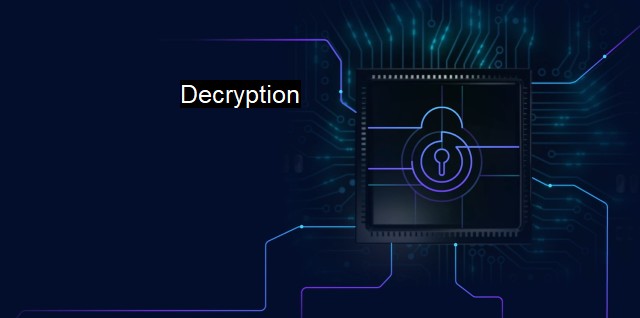What is Decryption?
Decryption: Crucial Role in Cybersecurity and Antivirus Protection Against Data Breaches and Attacks
Decryption, in the context of cybersecurity and antivirus software, denotes the process of converting encrypted data back to its original, understandable form known as plaintext. It's a fundamental component of many cyber protection methodologies that safeguard digital information against theft or malicious attacks. In a world where increasingly everything relies on digitalization, understanding decryption authorized access to crucial information protected by encryption algorithms.Encryption is a process whereby data is systematically transformed into an unreadable format using advanced algorithms and encryption keys. The primary purpose of encryption is to maintain information confidentiality, preventing unauthorized individuals from gaining access to sensitive data. While information is in its encrypted state, it is referred to as ciphertext. Encryption does not stop data interception but ensures that the intercepted data is incomprehensible to the unintended recipient thereby preventing misuse.
Inversely, decryption utilizes the same algorithms used during encryption but applied in reverse, along with the decryption key. The encrypted data or ciphertext is rendered back to its original form, plaintext, effecting a process that is essential in the domain of secure digital communication and information exchange.
In the cybersecurity realm, either symmetric or asymmetric encryption methods are employed dependent on the particularities of the situations. With symmetric encryption, the same key is used for both the encryption and decryption processes. Asymmetric encryption, conversely, uses two keys; a 'public' key for encryption and a 'private' key for decryption. The public key is accessible to any entity wishing to send secure data, but the private key is uniquely maintained so that only the intended recipient can decrypt that data.
To fortify cybersecurity, antivirus software employs decryption as part of its protective measures. Well-known antivirus applications, for instance, may apply heuristic analysis in decryption to detect previously unidentified malware. Such software decrypts the concealed piece of code to understand its behavior, this assists to identify malicious intent synonymous with new malware types.
Antivirus solutions also decrypt files that have befallen ransomware attacks. Ransomware is a rapidly-growing cyber-threat that encrypts victims' data, effectively withholding it hostage until a 'ransom' is paid. Some antivirus software can decrypt ransomware-encrypted files without paying the ransom, effectively neutralizing the attack.
Some sophisticated viruses also use encryption techniques to mask their true signatures, making them undetectable by conventional antivirus software. Modern antivirus solutions use decryption techniques to unscramble such encrypted viral content and appropriately classify and eliminate them.
Decryption also plays a role in digital forensics and incident response activities. Cybersecurity professionals frequently engage decryption to uncover and understand encrypted malicious actions. Through the use of decryption, malicious actions that were once concealed are brought to light, allowing for more robust remediation and preventive countermeasures.
These implementations signify the ongoing importance of decryption. Expanded demands for data privacy and safe online communications are fuelling the necessity for encryption and the correlating decrypting processes.
Decryption in cybersecurity and antivirus toolkits blends complex methodologies and keys in a systematic way to transform inexplicable ciphertext back into its original plaintext forma a coffee that can be effectively understood and used. Behind specific challenges ties to encryption-featuring threats, antivirus software regularly relies on decryption to safeguard users' digital information and experiences from cyber threats.
Following advancements in complex encryption algorithms over recent years, decryption had also consequently evolved. As cybersecurity threats continue to grow in complexity, advancing decryption's pivotal role within cybersecurity and antivirus solutions. Today, decryption isn't just a process but a device within a broader cybersecurity stratagem aiming to guard information, uphold privacy, and ensure secure--almost seamless--communication digitally.

Decryption FAQs
What is decryption?
Decryption is the process of converting encoded or encrypted messages or data into its original form, either manually or through an automated system. In cybersecurity, it refers to the process of decoding files or messages that have been encrypted by malware or viruses.How is decryption used in antivirus software?
Antivirus software uses decryption to analyze and detect malicious files or messages that have been encrypted by malware or viruses. The software decrypts the encrypted files, scans them for malicious code, and then quarantines or removes them to protect the system from harm.What are the common types of encryption algorithms used in decryption?
The most common types of encryption algorithms used in decryption are symmetric and asymmetric encryption. Symmetric encryption uses a single key to encrypt and decrypt data, while asymmetric encryption uses a public key for encryption and a private key for decryption. The choice of encryption algorithm depends on the level of security required and the specific needs of the application or system.What are some best practices for safe decryption?
Some best practices for safe decryption include using strong encryption algorithms, protecting private keys, and using trusted decryption software. Additionally, it is essential to scan decrypted files for malware or viruses before opening or executing them to avoid any potential security risks.| | A | | | B | | | C | | | D | | | E | | | F | | | G | | | H | | | I | | | J | | | K | | | L | | | M | |
| | N | | | O | | | P | | | Q | | | R | | | S | | | T | | | U | | | V | | | W | | | X | | | Y | | | Z | |
| | 1 | | | 2 | | | 3 | | | 4 | | | 7 | | | 8 | | |||||||